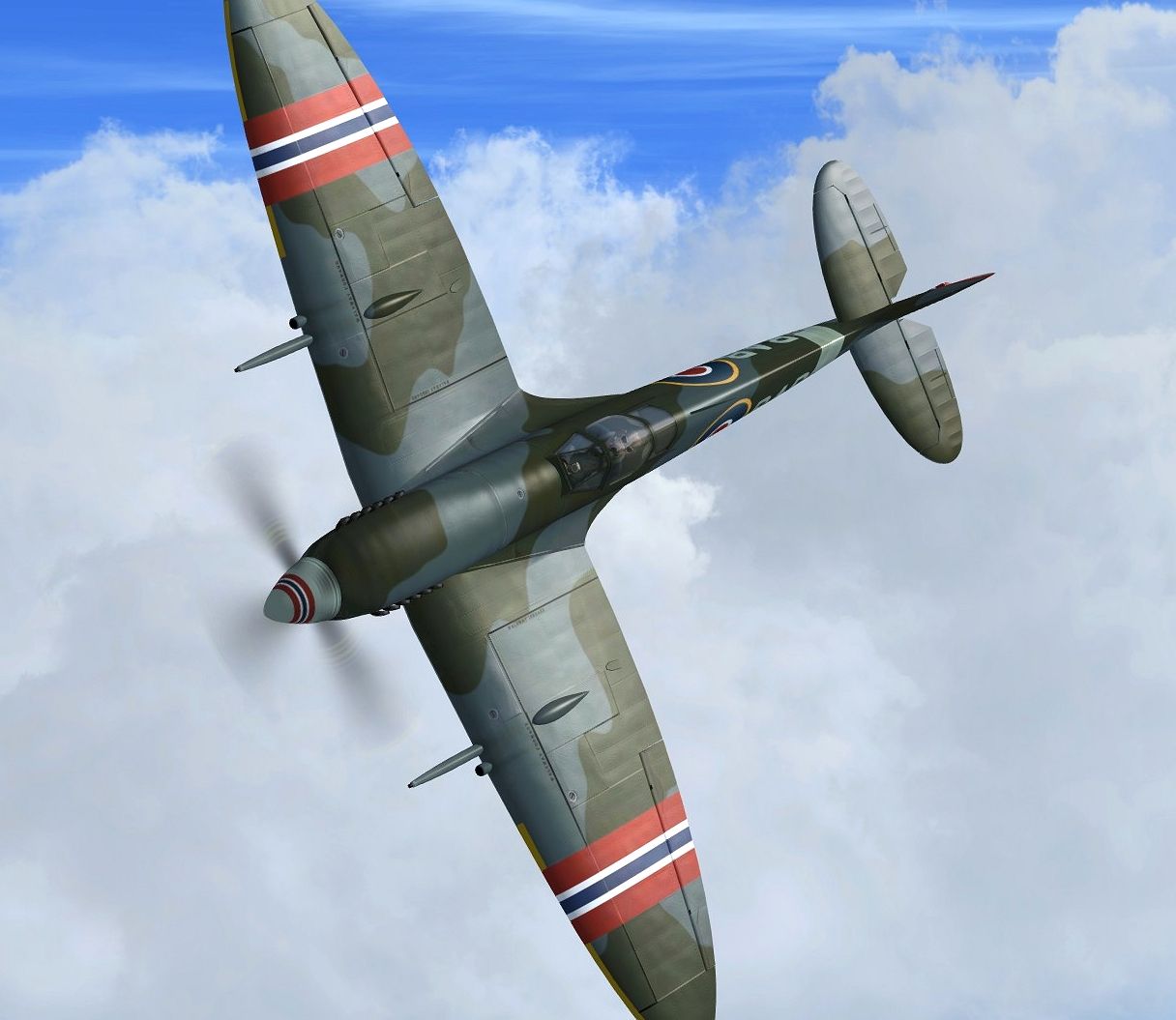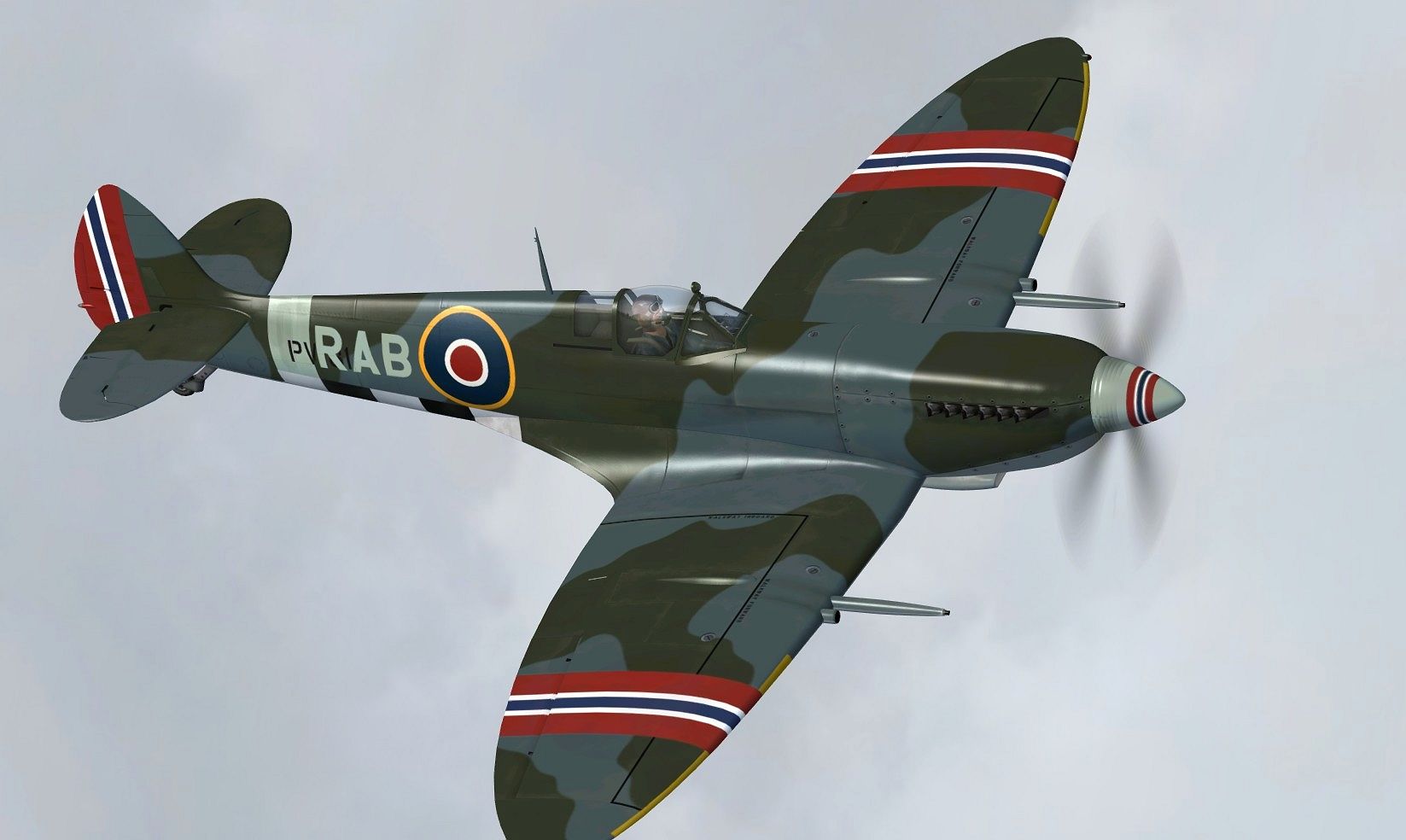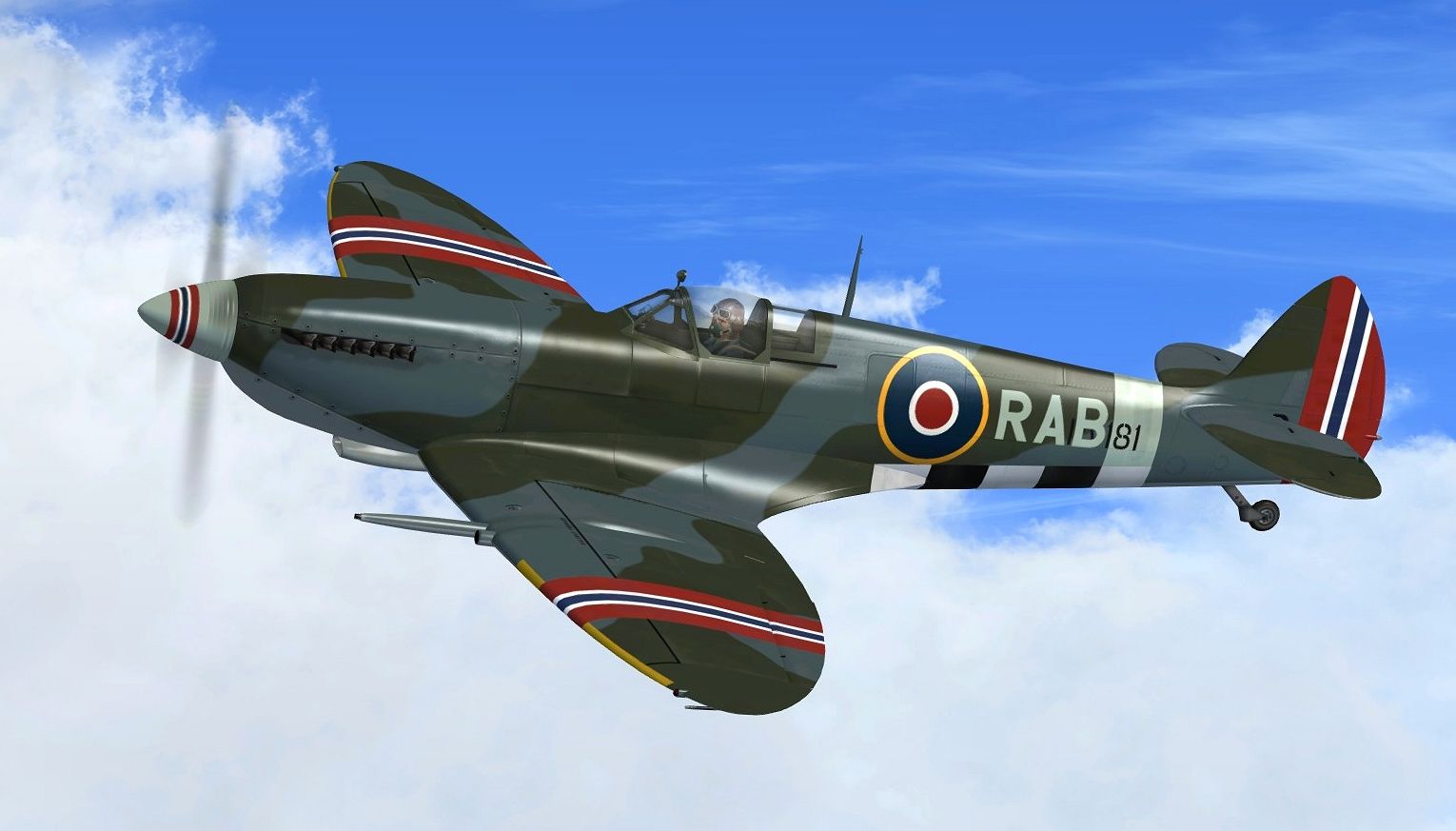-
There seems to be an uptick in Political comments in recent months. Those of us who are long time members of the site know that Political and Religious content has been banned for years. Nothing has changed. Please leave all political and religious comments out of the forums.
If you recently joined the forums you were not presented with this restriction in the terms of service. This was due to a conversion error when we went from vBulletin to Xenforo. We have updated our terms of service to reflect these corrections.
Please note any post refering to a politician will be considered political even if it is intended to be humor. Our experience is these topics have a way of dividing the forums and causing deep resentment among members. It is a poison to the community. We appreciate compliance with the rules.
The Staff of SOH
You should upgrade or use an alternative browser.
Norwegian Spitfire IX mega pack
- Thread starter JensOle
- Start date
JensOle
SOH-CM-2023
I'll also post the aircraft and pilot background info as found in the package:
1.IXc "AH-W" (BS507), 332 Sqn, 1942
BS507 "AH-W" was the personal aircraft of the Squadron commander, Major Wilhelm Mohr of No. 332 (Norwegian) Sqn in late 1942/early 1943. Mohr continued in the RNoAF after the war, his postings included "Chief of the Air Force" and he retired as a Lt. Gen in 1975. He flew in the Spitfire for the last time (so far!) in 2014.
2.IXc "FN-B" (MH603), 331 Sqn, 1943
This aircraft survived the war and is currently under restauration in Australia. Standard 331 Sqn scheme of the period.
3.IXc "AH-T" (BS255), 332 Sqn
BS255 "AH-T" of 332 Sqn was often flown by the ace 2.Lt Marius Eriksen. He claimed several of his 9 victories in this aircraft. It was also the aircraft he was shot down in on 2. May 1941 after first having shot down an Fw 190. Eriksen survived the war as a POW. He briefly continued to fly fighters after the war before becoming a businessman and noted sportsman.
4.IXc "FN-L" (MA568), 331 Sqn , 1943
MA568 "FH-L" was the personal aircraft of Captain Svein Heglund of No. 331 (Norwegian) Sqn, the highest scoring Norwegian fighter ace of WW2, credited with 16 victories. This particular aircraft was used during seven of Heglunds victories when he was serving in No. 331 Sqn of the North Weald Wing in 1943. Svein Heglund later also served with great success as a night fighter pilot flying Mosquito's with No 85 Sqn RAF, getting three BF-110 victories during bomber escort mission over Germany. Heglund continued in the RNoAF after the war and retired as a General in 1982.
The aircraft was also used by Lt. Nils Kolbjørn Jørstad for one victory in June 1943. The aircraft have 4+ probably destroyed German fighters on its tally.
5.IXc "FN-R" (BS125), 331 Sqn 1943
BS125 "FN-R" was often flown by 331 Sqn B flight commander Capt. Leif Lundsten. During the spring of 1943 Lundsten shot down both an Fw 190 and a JU-88 in this aircraft. He took command of 331 Sqn in the spring of 44 and led the squadron during the “D-day”. Sadly he was killed on 9th June 1944 when he was shot down by friendly fire from a naval vessel in the English Channel.
6.IXc "AH-Z" (EN177), 332 Sqn, 1943 Summer
"EN177" coded "AH-Z" of No 332 (Norwegian) Sqn. flown by B-flight commander Kaptein Werner Christie in the summer of 1943. At the time Christie was credited with 3 kills. He became squadron commander for 332 Sqn in 1944 and led the squadron during the D-day. Christie shot down 6 enemy aircraft in Spitfires. Werner Christie was one of a very few Norwegians which took command of both a British Squadron (234 Sqn) and later an entire wing (150th Wing/Hunsdon Wing). He shot down 4 enemy aircraft while flying the Mustang III and IV which brings his total to 10. After 244 operational missions he was shot down over Germany on 18 April 1945 and held as a POW until the war's end.
After the war Christie continued in the air force. In 1968 become a General, finally retiring in 1977. He died in December 2004 in Oslo.
“EN177” was also flown by 2.Lt Marius Eriksen on April 20th 1943 when he shot down a Ju-88 at 35.000ft.
7.IXc "AH-O" (ML244), 332 Sqn, 1944
ML244 "AH-O" of No 332 (Norwegian) Sqn. flown by 2.Lt Ola Gjert Aanjesen from the forward airfield Bognor Regis in the summer of 1944. This aircraft took part in the “D-day”. Aanjesen shot down 5 enemy aircraft and survived the war. After the war he continued to fly Spitfires as the squadron commander of 332 Sqn until 1946.
8.IXc "AH-Z" (NH171), 332 Sqn
NH171 "AH-Z" of No 332 (Norwegian) Sqn. flown by the squadron commander Major Werner Christie on the “D-day” (6th June 1944). For more information see texture set 6.
9.IXe "RAB" (PV181), 132nd Wing, 1945
PV181 "RAB" was the personal aircraft of Wing Commander Rolf Arne Berg of the 132nd (Norwegian) Wing of the 2nd Tactical Air Force in late 1944. As was the privilege of a Wing Commander, the aircraft bears his initials (RAB) as the aircraft code, but he also added Norwegian national markings on the wings and rudder. Rolf Arne Berg was by many considered to be one of the best Norwegian Spitfire pilots and he enjoyed high respect as a commander, he was credited with 6 victories. Tragically he was shot down by and killed during his final combat mission in February 1945.
10.IXe "RAB" (PV181), late scheme, 132nd Wing, 1945
Same aircraft as above, but at a later stage. RAF higher authority did not approve Bergs use of the Norwegian flag stripes on the rudder and wings and demanded PV181 to be brought back to RAF regulations. PV181 become one of the first Spitfire’s to be painted in accordance to the new marking regulations for the 2. Tactical Air Force. This included a small C1 roundel on the wings, no sky coloured band on the aft fuselage and a black spinner. The aircraft had this scheme when Berg was shot down and killed.
11.IXe "AH-F" (NH475), 332 Sqn, 1945 Homecoming
NH475 “AH-F” of No 332 (Norwegian) Sqn. as it looked during the homecoming flight to Norway in May 1945. Of interest are the C1 roundel on the wings, serial painted on the underside of the wings and of course the Norwegian flag stripes which was painted on the rudder. This aircraft also have the pointed rudder. This aircraft continued in RNoAF service after the war and was later coded A-AY. It was written off after a landing accident in 1949.
12.IXe "AH-S" (NH550), 332 Sqn, 1945 Homecoming
NH550 “AH-S” of No 332 (Norwegian) Sqn. as it looked during the homecoming flight to Norway in May 1945. Of interest are the C1 roundel on the wings, serial painted on the underside of the wings and of course the Norwegian flag stripes which was painted on the rudder. This aircraft has clipped wings. This aircraft continued in RNoAF service after the war and was later coded A-BO and AH-Z. See texture set 17 and 20 for additional schemes used by this aircraft.
13.IXe "FN-L" (MJ931), 331 Sqn, 1945 Homecoming
MJ931 “FN-L” of No 331 (Norwegian) Sqn. as it looked during the homecoming flight to Norway in May 1945. Of interest are the C1 roundel on the wings, serial painted on the underside of the wings and of course the Norwegian flag stripes which was painted on the rudder. This aircraft continued in RNoAF service after the war and was later coded A-AI. It was written off after an accident in 1947. See also texture set 15.
14.IXe "FN-Z" (PL187), 331 Sqn, 1945 Homecoming
PL187 “FN-Z” of No 331 (Norwegian) Sqn. as it looked during the homecoming flight to Norway in May 1945. Of interest are the C1 roundel on the wings, serial painted on the underside of the wings and of course the Norwegian flag stripes which was painted on the rudder. This aircraft has clipped wings. This aircraft continued in RNoAF service after the war and was later coded A-AS. It crashed after an engine failure in 1949, the pilot parachuted successfully.
15.IXe "FN-L" (MJ931), 331 Sqn, 1945 Summer
MJ931 “FN-L” of No 331 (Norwegian) Sqn. as it looked during the summer of 1945. As the Norwegian squadrons were still under RAF command, RAF roundels are still used. 331 Sqn introduced Norwegian flag stripes on the rear fuselage, covering the RAF sky coloured band.
This aircraft continued in RNoAF service after the war and was later coded A-AI. It was written off after an accident in 1947. See also texture set 13.
16.IXe "FN-K" (PT882), Feltflyvingen, 1946
PT882 "FN-K" of the "Feltflyvingen" of the Royal Norwegian Air Force in 1946. The "Feltflyvingen" was a short lived cadre/Operational training unit in the immediate post war years when both 331 and 332 Sqn were temporarily disbanded due to personnel shortage. It still carries 331 Sqn codes.
17.IXe "AH-S" (NH550), 332 Sqn, 1946
NH550 “AH-S” of No 332 (Norwegian) Sqn. as it looked in 1946. At this stage the RAF roundels have been overpainted with the new Norwegian roundel. The fuselage roundel has the same size as the British, but the wing roundel is smaller. 332 Sqn introduced Norwegian flag stripes on the tailfin in a position similar to the RAF tail flash. This aircraft have clipped wings. This aircraft was later coded A-BO and AH-Z. See texture set 12 and 20 for additional schemes used by this aircraft.
18.IXe "A-CD" (JL361), 331 Sqn, 1950
Spitfire Mk IXe JL361 "A-CD" of 331 Sqn of the Royal Norwegian Air Force in 1950. From 1946 the RAF wartime squadron codes were changed to a new system with one aircraft type letter (A for Spitfire) and two individual aircraft letter codes regardless of the squadron. This new system was not popular with the squadrons and during 1951 the old squadron codes were reintroduced.
19.IXe "AH-H" (MK671), 332 Sqn, 1951-52
Spitfire Mk IXe MK671 "AH-H" of 332 Sqn of the Royal Norwegian Air Force in 1951. It has a pointed rudder. Standard Norwegian scheme after regulations of 1951 which brought the old squadron codes back into use.
20.IXe "AH-Z" (NH550), 332 Sqn, 1951-52
Spitfire Mk IXe NH550 "AH-Z" of 332 Sqn of the Royal Norwegian Air Force in 1951. At this stage of its career it has got normal wing tips and a pointed rudder. Standard Norwegian scheme after regulations of 1951 which brought the old squadron codes back into use.
21.IXe "FN-L" (PL912), 331 Sqn, 1951
Spitfire Mk IXe PL912 "FN-L" of 331 Sqn of the Royal Norwegian Air Force in 1951. It has a pointed rudder. Standard Norwegian scheme after regulations of 1951 which brought the old squadron codes back into use.
22.IXe "FN-C" (ML363), 331 Sqn, 1951
Spitfire Mk IXe ML363 "FN-C" of 331 Sqn of the Royal Norwegian Air Force in 1951. It has a pointed rudder. Standard Norwegian scheme after regulations of 1951 which brought the old squadron codes back into use.
JensOle
SOH-CM-2023
Rolf Arne Berg enjoyed high respect as a commander and he was credited with 6 victories. Tragically he was shot down and killed during his final combat mission in February 1945. He had actually finished his last tour and was about to be rotated back for staff duties. He wanted to fly one more mission and talked his superiors into letting him fly one last mission leading a strafing mission against possible german aircraft at Eelde. He was well know for his high level of professionalism in planning and execution of missions, but on this tragic mission he broke his standing rule of attacking with the external fuel tank still attached.





